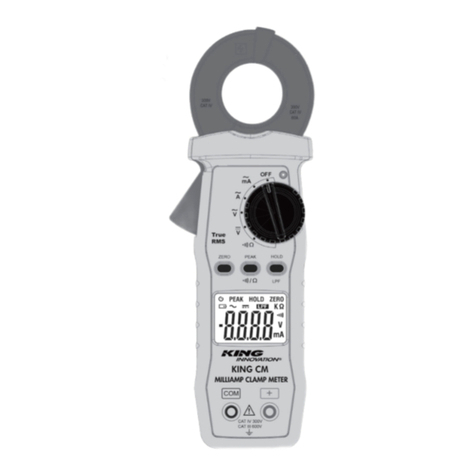
8
I
KING INNOVATION KING INNOVATION
I
9
KING 521MANUAL DE INSTRUCCIONES
• El extremo de un cable cortado o roto se puede localizar siguiendo la
ruta hasta que desaparezca la respuesta nula y dé lugar a un punto
caliente. Más allá del punto caliente, no se puede detectar ninguna
respuesta nula. Retroceda hasta que se detecte la respuesta nula y este
será el extremo aproximado del cable roto. (Consulte la Figura 3)
• Se pueden localizar melladuras más grandes en el cable de la misma
manera que se localizan los cables cortados. Siga la señal nula y
potente a lo largo de los costados del cable hasta que la señal se
vuelva muy débil a lo largo de la respuesta nula. Esto ocurrirá dentro
de una distancia relativamente breve. La señal transmitida se purga a
tierra en la melladura y luego querrá regresar a la punta de tierra a lo
largo del exterior del cable mismo. La mayor parte de las señales se
detendrán en la melladura indicada por la lectura baja del receptor
apenas más allá de la melladura. (Consulte la Figura 4)
• Para definir con mayor precisión la ubicación de una melladura abierta
o más grande (fallo a tierra), ubique la punta del receptor sobre el
suelo cerca del punto donde se detectó la última señal potente a lo
largo del costado de la ruta. La punta del receptor también debe
estar orientada al suelo y estar aproximadamente a 6 pulgadas hacia
ambos lados de la respuesta nula. Debido a que está mucho más
cerca de la ruta, la perilla de sensibilidad se debe ajustar abajo hasta
que la lectura del medidor sea justo menos de 10.
Mientras se mantiene la distancia de 6 pulgadas de la respuesta nula,
mueva el receptor a lo largo de la línea, prestando mucha atención a
la lectura del medidor. Después de pasar la apertura o la melladura, el
medidor bajará rápidamente.
Determinación de la profundidad del cable
Para determinar la profundidad del cable, marque primero el suelo
directamente por encima de la ruta. Gire el receptor lateralmente
hacia la ruta e inclínelo 45°. Mueva el receptor para alejarlo de la
ruta, manteniendo la punta de 45° hasta detectar una respuesta
nula. Marque este punto. La profundidad es la distancia entre las
dos marcas. (Consulte la Figura 5)
Proceso de localización de válvulas solenoide de dos tiempos
Las válvulas de solenoide se pueden localizar siempre que todos
los cables que llevan a ellas estén intactos y el solenoide mismo
aún esté en buenas condiciones.
Paso 1
1. Configure el transmisor como en la “Sección de configuración”.
La respuesta nula estará presente hasta que pase por encima de
una válvula de solenoide y luego la señal se volverá sumamente
potente. Marque este punto. Verifique alrededor del punto
caliente para detectar una respuesta nula que salga de la
zona. Si la respuesta nula continúa, sígala y marque los puntos
calientes adicionales. (Consulte la Figura 6) Si solo se localiza
un punto caliente o una válvula, será la válvula en cuestión.
FIGURA 3: Localización del
extremo de un cable roto
FIGURA 4:
Localización de una
melladura del cable
FIGURA 5:
Determinación de la
profundidad





























